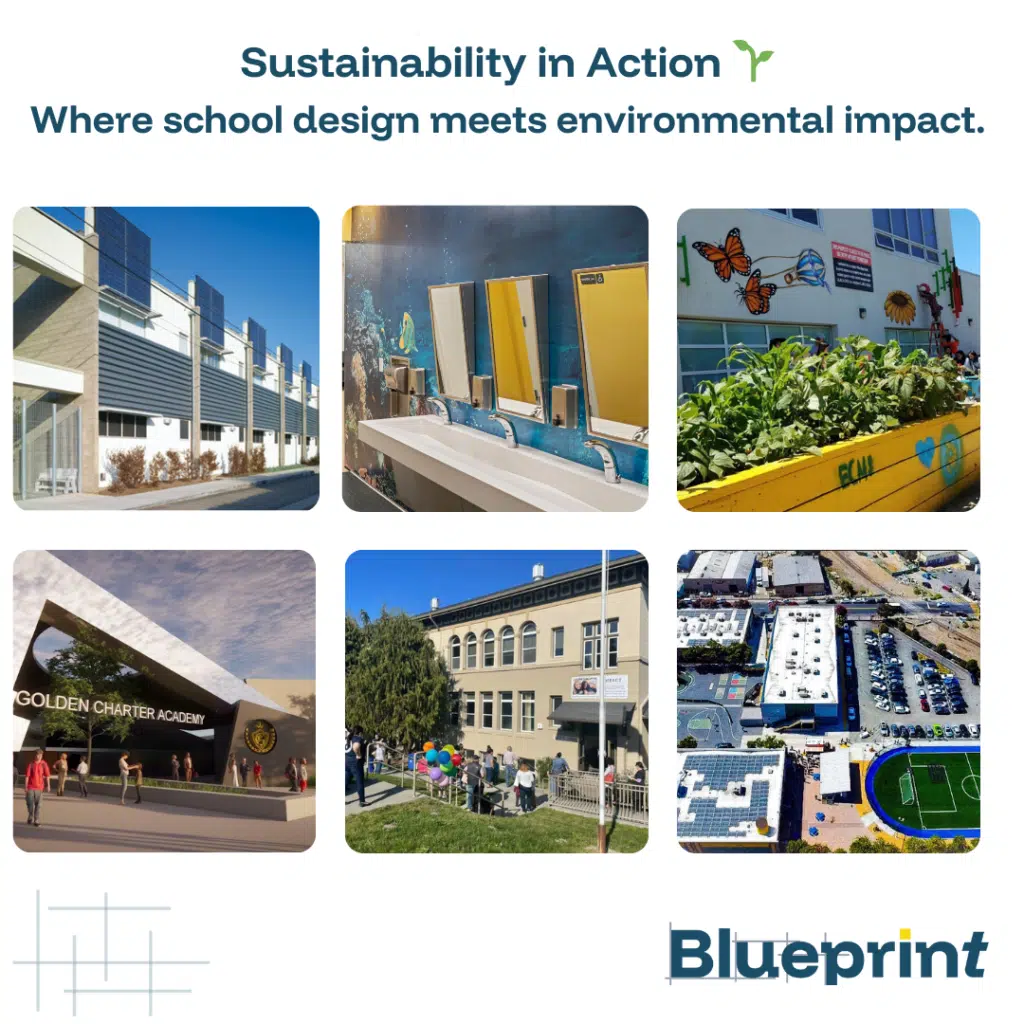At Blueprint, we believe that designing for students means designing for the future. From reducing our carbon footprint to improving air quality and conserving natural resources, we see school facility projects as an opportunity to ensure environmental responsibility.
Sustainability Is Not an Add-On—It’s Built In
Our approach to sustainable design starts at the earliest planning stages. We collaborate with school leaders to understand their values, priorities, and long-term goals, then weave in eco-friendly strategies as it makes sense for their site, budget, and students. Whether it’s installing solar panels, integrating water-saving features, or prioritizing natural daylight, we ensure that sustainability is more than a checklist.
One of the most powerful tools we have in our climate toolkit? Adaptive reuse.
Adaptive Reuse: Preserving the Past, Protecting the Future
Adaptive reuse—the renovation and repurposing of existing buildings—is a major carbon reduction strategy. Instead of starting from scratch and generating tons of construction waste, we work to breathe new life into old buildings. This dramatically lowers the environmental impact of a new school facility while preserving community history.
A standout example is our project with Impact | Commencement Bay Elementary in Tacoma, WA. The school is located in the historic John Rogers Elementary building, originally constructed in the early 1900s and one of the first reinforced concrete elementary schools in the state. By repurposing the structure, we avoided the emissions and material waste associated with demolition and new construction, all while delivering a beautiful, modern campus that serves 600 students in grades TK–5.
Learning Through the Environment: Schools Where Sustainability Shapes the Curriculum
For some of our partners, sustainability goes beyond the facility—it’s embedded in the mission of the school itself. Two standout examples are Environmental Charter Middle School in Gardena and Golden Charter Academy in Fresno, where environmental education is a core part of the student experience.
- Environmental Charter Middle School – Gardena, CA
ECMS doesn’t just teach students about sustainability—it lives it. The campus is designed as a hands-on learning lab, featuring organic gardens, aquaponics systems, on-site composting, and rainwater harvesting. Students are engaged in environmental stewardship every day, whether they’re tending to drought-resistant native plants, working in the bike shop, or learning about resource conservation through the school’s low-flow fixtures and smart irrigation systems. The design supports their mission to develop future leaders who will protect and sustain the environment. - Golden Charter Academy – Fresno, CA
Golden Charter Academy was built with a vision: to create a learning environment that fosters environmental justice and deepens students’ connection to the natural world. From day one, the facility is being designed with green building strategies and energy-efficient features, continuing their focus on a curriculum centered on environmental science and outdoor learning.
These schools exemplify how sustainable design and environmental education can work hand-in-hand to create transformative, mission-driven learning environments.
Green by Design: Partner School Highlights
Beyond adaptive reuse, many Blueprint-supported projects incorporate sustainable features designed to conserve energy, manage resources, and promote eco-conscious learning environments:
- Citizens of the World LA – Silverlake Middle School
Built with long-term sustainability in mind, this campus uses sensor lights and water faucets to minimize energy and water waste. - Ánimo Venice Charter High School – Venice, CA
Designed with solar panels and sustainable materials, this school reflects a commitment to clean energy and thoughtful construction. - Lodestar – Oakland, CA
A severely damaged field was transformed into durable turf to reduce water use. The school also added solar panels and ample bike storage to encourage green commuting and clean energy use.
Building Toward a Better Future
We know that today’s students are tomorrow’s environmental leaders. That’s why we’re committed to helping our school partners build campuses that reflect their values—not just educationally, but environmentally, too.





Leave a Reply